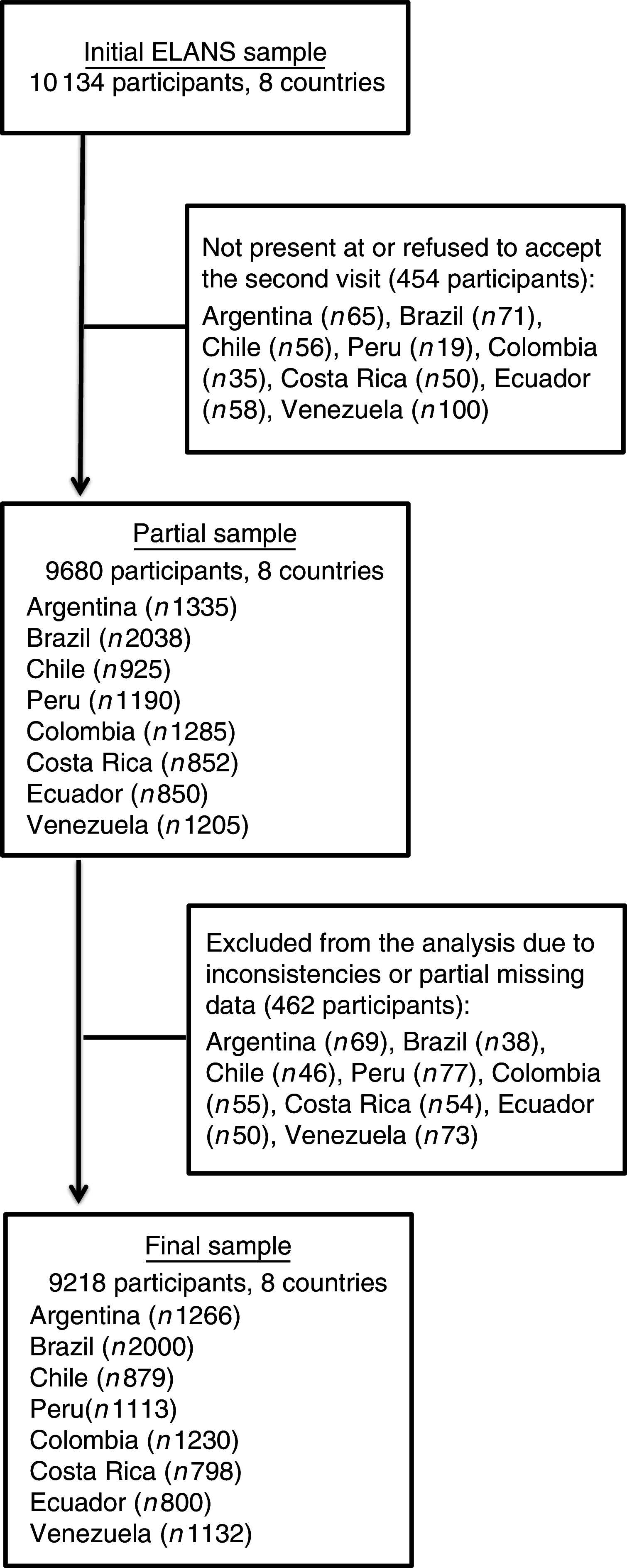Energy intake and food sources of eight Latin American countries: results from the Latin American Study of Nutrition and Health (ELANS)
- PMID: 29848396
- PMCID: PMC10260935
- DOI: 10.1017/S1368980018001222
Energy intake and food sources of eight Latin American countries: results from the Latin American Study of Nutrition and Health (ELANS)
Abstract
Objective: Few previous studies in Latin America (LA) have provided data on dietary intake composition with a standardized methodology. The present study aimed to characterize energy intake (EI) and to describe the main food sources of energy in representative samples of the urban population from eight LA countries from the Latin American Study in Nutrition and Health (ELANS).
Design: Cross-sectional study. Usual dietary intake was assessed with two non-consecutive 24 h dietary recalls.
Setting: Urban areas from eight countries (Argentina, Brazil, Chile, Colombia, Costa Rica, Ecuador, Peru, Venezuela), September 2014 to July 2015.
Subjects: Adolescents and adults aged 15-65 years. Final sample comprised 9218 individuals, of whom 6648 (72·1 %) were considered plausible reporters.
Results: Overall, mean EI was 8196 kJ/d (1959 kcal/d), with a balanced distribution of macronutrients (54 % carbohydrate, 30 % fat, 16 % protein). Main food sources of energy were grains, pasta and bread (28 %), followed by meat and eggs (19 %), oils and fats (10 %), non-alcoholic homemade beverages (6 %) and ready-to-drink beverages (6 %). More than 25 % of EI was provided from food sources rich in sugar and fat, like sugary drinks, pastries, chips and candies. Meanwhile, only 18 % of EI was from food sources rich in fibre and micronutrients, such as whole grains, roots, fruits, vegetables, beans, fish and nuts. No critical differences were observed by gender or age.
Conclusions: Public health efforts oriented to diminish consumption of refined carbohydrates, meats, oils and sugar and to increase nutrient dense-foods are a priority in the region to drive to a healthier diet.
Trial registration: ClinicalTrials.gov NCT02226627.
Keywords: Energy intake; Food sources; Latin America; Plausible reporters; Survey.
Figures
References
-
- Bermudez OI & Tucker KL (2003) Trends in dietary patterns of Latin American populations. Cad Saude Publica 19, Suppl. 1, S87–S99. - PubMed
-
- Popkin BM (2004) The nutrition transition: an overview of world patterns of change. Nutr Rev 62, 7 Pt 2, S140–S143. - PubMed
-
- Kelly T, Yang W, Chen CS et al.. (2008) Global burden of obesity in 2005 and projections to 2030. Int J Obes (Lond) 32, 1431–1437. - PubMed
-
- Silventoinen K, Sans S, Tolonen H et al.. (2004) Trends in obesity and energy supply in the WHO MONICA Project. Int J Obes Relat Metab Disord 28, 710–718. - PubMed
Publication types
MeSH terms
Associated data
LinkOut - more resources
Full Text Sources
Other Literature Sources
Medical


